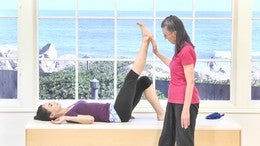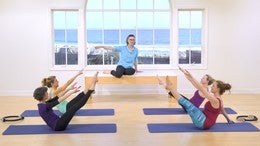Description
About This Video
Transcript
Read Full Transcript
Good afternoon. I'm Michelle Larson. This is Ruth Alpert. We're here to go over some simple problem solving, basically simple modifications to help us learn how to do roll ups better. Learn how to do rolling like a ball without the clunk. Clunk is hopefully learning how to do legs, circles, extensions, breathing, et Cetera to make it a little more efficient for you. Basically we're going to start first with breathing because most of the people, myself included in this country are either belly breathers or their front chest breathers. And when you do polato days there, you need to really use your entire rib cage to breathe.
So if you have a theraband going to have Ruth put her back towards you, you just take the theraband and keep it as wide as you can and put it around your ribs, breathe in front of you, cross it and hold on one stroke in each hand and then sort of pull your hands forward so you have tension back into your ribs. And then what you want to do is you want to breathe and move into the back of the ribs. So the side back of the rib cage is what you want to practice breathing into. So you get that sense of expansion back here. Cause you know many of the fact, I think in classical form, all the plot is exercises. Start on inhale.
So if you're doing a roll up and you're going to inhale and your chest breather and you breathe like this, you've immediately defeated your Rola. So what Ruth is going to do, we can take this away. She's just going to go lie down with her head this way I think. And just put the hands behind your head. You're just gonna do a head roll up and inhale into the back of your lungs as you do it.
And it does offer you a little sense of pushing you up into that question mark space, right? And then you can do it coming up again.
So there's a couple of helps there. Okay. Now we're going to go continue with rollup since you're here and we'll just grab a magic circle. And this is not [inaudible]. It's basically a way to, how can I say it? To lock your spine, the bones of your spine. Communicate with your pelvis bone as it changes, as your whole relationship to legs and pelvis change. You're all out here flat and you're gonna end up seated.
So you're going to end up flux. You're getting up into roll up. But I don't want you to use your abdominals. So take a magic circle, a bathroom taught, you know, a bathrobe tie. Anything. Hold on. Yeah, this leg is slightly bent so it's soft. You don't want to use your stomach muscles, you don't want to use your abs. You want to use this leg as a lever, like a teeter totter lever to roll up.
So you press into the circle and you slowly roll all the way up to sitting and then you just roll back slow. Keep this knee bent, hang in a way on this circle. Press the foot, go slow enough so that you could reverse the direction at any time. And what you're trying to do, go all the way is let your spine articulate vertebra by Vertebra without you interfering with it, imposing a form. Does that make sense? Plus it stretches out your hamstrings.
This is actually one of the hardest things for [inaudible] people to learn because they want to do something. Don't do anything. The only thing you do is you just think of yourself as a teeter totter and you try to figure out the forces of pressing the foot into here. Rolling down so that you don't go quickly, you just, it's really slow and you can articulate like a string of pearls coming off the floor and one more. So that might also help with a roll up, do this couple of times on one leg a couple of times on the other, and then you have more articulation through the spine to do a simple roll-up. If none of those work, there's another one.
If you're more Dodick lordotic needs what? In my generation we called sway backs. You're really have an arch here in your spine so that when you're lying down a lot, like Ruth is demonstrating. Now you see, here's my hand, right? There's nothing there. You can just simply take a towel and it depends upon how lordotic you are. This might be a little big, but it'll show better and place it under the waist.
And what's you're effectively doing is you're bringing the surface up to fill up the gap so that when you come up, it's like when you did the leg lever roll up, as I call it, you have to have oppositional sensation. I mean when we move you, you do have oppositional stretch of the body and that's really important. Otherwise, you know, you, you head all in one direction, but as you come up, when you're working against gravity, if you can't feel the part that has to be on the floor dropping down, as you continue to roll up, if there's always the gaps there, then you don't have any floor literally to come up on to. Does that fat makes any sense? Um, if you've got a scoliosis like I do, it's really important because one side, you only feel one side of your spine all the time on the floor and the other side, it's not touching anything. So if you, those of you who don't have a scoliosis, you'll feel both your muscles on both sides of your spine resting on the mat like this as you roll up. But if you've got a gap, you're lordotic or scoliotic, you're not going to feel that. So then you're going to have to make some sort of compensation because you don't have a foot down to help you roll up, if that makes any sense. So do a roll up just easy so she can just roll right up through that lordosis very easily and then roll back down and eventually, and it may take months, maybe years.
You don't need all of these little things or maybe you always do when you warm up, you have to do a couple of leg levers on your bad days. You've got to stick the towel under your waist. So Ruth is going to demo without the towel and watch what in through this area as she tries to roll up w w you rolled up with the towel already a few times. So now she's going to go without the towel and just watch what she has to do in order to come up in order to come up and get this down. She's tucking her pelvis forward, which is creating an oppositional movement to the upward movement.
So she's trying to go this way or body's going this way. It's going, ah, and all this stuff is going on. So that's why you have the towel. Basically. In my generation of learning Pilatos we, I learned all the mat work with a mat that had a strap. So you hooked your feet under a strap so you could cheat your way through and you couldn't get your weight. You're back down. You can sort of Yank yourself up a little bit. But in a mat class, like that happens a lot. You can't do that. So you can use little ankle weights, little padded weights like this.
If you put these
So then I thought we would look at leg circles because many people can't get their leg perpendicular to the ceiling. So bring this one up.
So she came up with something called Niesters. So what you do is you bring this leg up, you use your hand on top of the knee and use the arm to circle the leg around in the socket, and you keep it small and you keep it small. The idea is, is to say to your hip socket, you see, you can do this right? You know, this makes sense. And then she's going to go the other way. Now if you're going to go with this version of leg circles and you go to straighten the leg, I want Ruth to put her hand right in here. Now there's a tendon right there that on most people when they straighten the leg, it grabs, it looks like a guy wire that you see on those telephone poles.
And that is effectively just relax for a second. It's effectively like wadding up a sock, opening the door, putting the sock in the jam, and then trying to shut the door. But it doesn't work because when that tendon grabs and holds on to hold your leg up against the pull of gravity, it blocks the fluxion to clean flection the joint. So what I do is I'll have Ruth come up to here, bring it all the way up, keep her fingers right there gently in the joint and straighten the leg is as far as she can without that tendon popping. Even somebody flexible, right? And then it's in this position that she does legs circles and she keeps them small, right?
So you get to feel the weight of the leg dropping down into the joint. I personally prefer this to thera-band. That's my personal hips. You want to use your other leg. So she's going to do a little niesters. Well now a few in the other direction, and then straighten the leg and then you can use a theraband which supports the leg.
Alright, so whichever one works for you or try and both, right. One where you just make sure that that tendon doesn't pop, but there's no theraband and you circle the leg, right? Yeah,
If you're going to do classic roll-ups or we're going to do a full roll up the arms overhead. Inhale is the arms and head come up. So she's breathing here. Exhale. As she continues, she just stays round. Inhale into the back of the ribs, which tends to lift the rib cage off the pelvis and rollout on the exhale.
Niesters the extension without the twain or that's the very sophisticated word for it popping up and becoming a sock and a door jam. Right. You know, you either can do it by, keep it, you can get rid of that by keeping the knee bent or you use the theraband, whichever works for you. I also want to say something here about leg circles was remembering the way Eve taught me years ago. The other day I couldn't bring this knee up and straight, right? When you went to cross, you slightly inwardly rotated and then when you came out you slightly outwardly rotated so you had a slight, it's very slight and slight.
If you go the other way, it's slightly out and slightly in and again it's so you're actually rotating the leg in the socket as well as circling the leg in the socket and it's very gentle. It's very soft. You find that's enough. You find your way of doing it. I mean, you know, if you've got really open hips, closed hips, that'll alter that, but that is better. It's more comfortable and it puts less strain. It's also better if you make an oval in this direction rather than this direction. Right? Oh, it's hard to take it way out. Okay. We talked about rolling [inaudible]
Scooch up a little bit so you don't,
What you're trying to do is not using your arms using just that sense of a ball rolling down and up inside your body. You're trying to roll right on that part of your back. That's it. Then she would allow you to do rock and roll, so come all the way up, hold underneath the legs and use your legs. Boom, and come forward. Now the use of the legs is less for momentum than it is for you getting this part down on the floor. Does that make sense? So you lax it.
That's it. One more good and come up. Yeah. Great. Yes. Sit. Just relax. Okay. There's extension but there's also rotation and I do want to deal with rotation before I deal with extension. I think you should in your own body and I'm going to show you why Ruth's going to come over and she's going to lie on her belly with her forehead on her hands.
You do. You should do this for yourself. All right, and the test, this is the test is that she's just going to look forward like she was a child and line on her belly. She's just going to look forward. And that's as far as she goes. That's what she can see. And then she comes back down. All right, so her and childhood development terms, it's called writing reflex, but it's here. It's just her extension through the spine. So she looks up and looks for something. That's it. And that's it.
And that's her natural stuff. Now what we're gonna do is we're going to put rotation in the spine. So we're going to sort of do it sneakily. Okay. So I'm going to ask Ruth to turn her toes underneath her and slowly straighten both knees. Now think of your heels as windshield wipers and take both your knees to one side slow and let your pelvis follow there.
So there's rotation that's come all the way up to this part and then she's going to come back slowly and she's going to go the other way. Rotation coming all the way up to that dorsal hinge part there. Alright, do it again. No, come back. Center. Release your toes and now look forward again.
Sit facing this way in saw cause that's your saw his saw position legs out. Cause saw comes before extension in the mat work. Right. Scoot back. So your legs are on the thing and we're going to open the legs more just because we've got this thing and we can now you're going to take this leg arm and you're going to put it here. This is not a lot. Right. Okay. Right.
And what you're going to do with the hand is you're going to think that your, you're doing this route and you roll through this hole. Yeah. Yeah. But yeah, this arm reaches back like it's in saw. So this hand, you're turning a knob and you're reaching back. Good. And you come up and do that on the same side again. So you're turning and mob, you're there, you go and coming up and again, and you're, what that does is in here, right? It really helps through this area. Try the other side. Okay. So there is just a made up thing. I now go to [inaudible] to saw. Okay. Yeah.
And just classic saw. There you go. And then the other way makes it a little easier, doesn't it?
And it becomes more about the shoulder reaching around and rotating the chest. Yes. There you go. There you go. Yeah. Yeah. So you sort of imagine you're doing this even though you're taking your arm off. There you go. Yeah.
So if you just sort of think about that when you're trying to do extension and if it's not working that day, rotate. Okay, extension, we've done the rotation and you can see that frees up the neck. The beginning of extension extension does start with the head. You just don't overdo the head, but you don't drag the head up either. There are a number of, I mean extensions, difficult for everyone. So there's 60 zillion different ways to begin to do it.
What I'm gonna do is I'm going to teach a little bit of a pattern. So what she's gonna do is she's going to come up into a sphinx position. But yeah, and then roll back down. Good. Now what I really want you to pay attention to when you do that is that you engage your lats. You sort of think of your elbow back here, pulled here, and then slide the hands out a little bit, and then put your hands in, right?
So you have elbow to here, up to here, and then slide the hands out and come down. So it's really simple. So you connect. If you connect from the elbow through the back of the shoulder, down to the pelvis, right? You'll protect your low back. So if she pulls that connection in, she's protected. If she lets the connection go, let this go. Look what happens.
She goes right into here. But if she makes that connection, presses into the floor, connects through the lab, basically connects to the pelvis. Your lost, your low spine is supported. So come all the way. Yeah. And then come all the way down. Right? So just shake for a minute. So that's the easiest way to connect into extension. But there's another part to extension and that's the part down here so that when you get on the reformer, you're trying to do a big, you're trying to do the swang rocking, et cetera.
Many of us are really tight in here, hip flexors. So what I'm going to have her do is bring your legs a little closer together and turn your toes underneath and slowly straighten the knees and drop those hip sockets and hip bones into the floor and then bend your knees and then slowly straighten the knees and drop those hip s I s s as is and back down.
Now Bend, keep the knees on the mat, but keep the feet there. Keep the weight here and these two bones and find this connection and come up into extension. They're beautiful. So you can go the whole way. Yeah. Now stay here and do round and arch right up here. Try to do it here. This will follow along.
But you push the elbows away when you round and you pull the elbows towards you when you are. So you're only talking about this, you're trying to stay heavy here. You okay in your low back and go the other way. And last one you push the elbows away or arms away. And did it go the other way? You pull your arms in and then you slide your hands out and roll down and shake.
Really she toes and shake. Good. And then sit back and rest position. Oh, I have something else. I think I have a few minutes. Scoot up on here and back up a little bit. There you go. So most people can't put their, the top of their foot down. Men more than women because women tend to run around in heels and barefoot and et cetera. A little more.
So I do a version of rest position into support on the hands. So on an inhale, come forward and take the weight onto your hands. Just up onto your knees, turn your toes underneath you and sit back and stretch the bottom of your feet. Inhale, come forward. Turn your toes over. Is this okay? Yeah. And inhale, come forward and stretch and inhale and stretch.
One more set of that. So this is great for feet and going back. Good. And just relax. Okay. I think that's probably enough for today. You sit up, right. Thank you. These are just ideas that we've come up with to help us move. In other words, to make Pele's enjoyable, you should be able to do it effectively and comfortably.
And so you can just try and you can modify it to work with your body. There are a lot more things we could have chosen, you know, just in roll up, bend the knee, straighten the knees, I'll go right. You know, zillion things you can do and I think you should feel free to try them so that that makes you capable of doing the work. Thank you.
Comments
great tips really. Was the extension after rotation much better because of spine elongated after rotation?
Thanks!
Thank you for supporting the introduction of modifications in fundamental Pilates' work. This allows 'all' bodies to gain motion and understanding, supporting the positive influence of our ability to provide knowledge in the fitness/wellness world.
You need to be a subscriber to post a comment.
Please Log In or Create an Account to start your free trial.



















